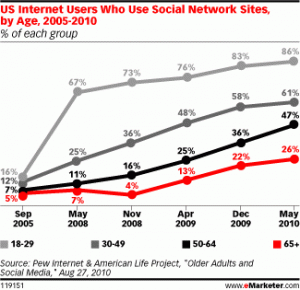The History of Social Media
Over the last three decades, technology redefined social interaction. Internet connectivity demolished geographical barriers to communication. At the same time, new devices and greater access to more advanced computers and mobile phones certainly accelerated the process of bringing the world together, no matter how disparate the cultures may be.
What is Social Media
Social media refers to all web-based applications and mobile communications technologies that allow users to design and exchange ideas, often in real time. Essentially, social media facilitated the growth of interactive dialogue among communities of users regardless of their physical locations. Social networking services provide a way for users to find one another, then communicate with each other using email and instant messaging.
Social networking has become increasingly pervasive in recent years with smarter mobile devices and more accessible apps. But before there was Apple‘s iPhone and iTunes, Mozilla Firefox, Facebook, Twitter, and Yelp, there was a long history of non-integrated user to Internet experience.
Rise of the BBSs
In the 1970s, Bulletin Board Systems were online meeting rooms for like-minded individuals. Often managed by hobbyists, the central system was accessed through a modem connection for text-only downloads and to post messages for other members. BBSs were typically technology-oriented. Memberships were local because long distance charges applied to modem hook-ups.
CompuServe and Electronic Mail
At about the same time, business computer mainframes relied on CompuServe for communications. The service was expanded to include public access so that members could access current events, share files and exchange ideas in various CompuServe forums. CompuServe did not create email but they were the first to allow wider public access to the service.
America Online Amps it up
AOL began as an online service for downloading games through a proprietary modem that allowed offline access to downloaded media. It evolved to become the Internet of its day providing a platform for member-created communities to interface with each other. Searchable member profiles became the norm in AOL communities. Unlike CompuServe, AOL provided an accessible platform for those who were not tech-savvy, encouraging members to communicate with each other thus becoming the dominant player in the 80s and 90s. In 1997, with their platform came an add-on named AIM which propelled them to even greater heights.
The Internet Spawns a Marketplace
By the 90s, Silicon Valley was incubating the start-ups that would grow to be tech giants. Yahoo and Amazon were in place. Other start-ups focused on mass production and distribution of personal computers (Dell, and others), the device that is largely responsible for entrenching Internet dependence in today’s culture.
Reconnecting with Lost Connections
As Internet connectivity accelerated, interactions became more focused. Rather than seeking out random strangers with tenuous links to one’s interests, family and friends from the past became the object of searches through Classmates. Profiles were searchable and systematically grouped. It was well-received.
SixDegrees was a similar site that encouraged surfing other member profiles and establishing a connection to existing members while soliciting new ones. Spamming issues led to the collapse of SixDegrees but other services were quick to pick up the slack.
Friendster Takes Over
There were many social networking sites in the late 90s, with several of them targeting a specific demographic. However, Friendster stood out because it capitalized on the SixDegrees networking concept. It refined this strategy into the Circle of Friends network where member connections were defined along a path. It garnered three million users in its first year alone.
LinkedIn for Pros
Appealing to a more sedate crowd, LinkedIn was established in 2003 to provide a place for professionals to post their profiles and to create connections with others in and outside their industry. LinkedIn successfully adapted business networking to the Internet, facilitating user interaction with various connections in a more restrained atmosphere, one that prevails even today. However, BranchOut is now attempting to capitalize in using the Facebook network to draw users to their business professional social network.
MySpace Makes its Mark
In 2003, MySpace favored a younger, hipper approach to social networking. The interface was decidedly appealing to young adults who were into music, music videos and funky extras. It picked up disgruntled Friendster users and lorded it over other social networking sites for a while. Changing ownership a few times, Myspace is no longer regarded as the powerhouse it once was.
Facebook Becomes the It Place
In 2004, Facebook began as a social networking site for Harvard and other university students. By 2006, Facebook was opened to public membership and interest skyrocketed immediately. It has about 750 million members worldwide. Being the #2 site worldwide (Google remains #1), talks of the company going public has created an epidemic of individuals being defrauded into buying their stock before it became openly available to the public.
Twitter the Phenomenon
Twitter gave new meaning to concise communications. As a micro-blog that is linked to hand-held devices, it thrives on public interest in real-time updates from celebrities du jour. Many turn to Twitter when they want to know the most up-to-the-second information as it becomes available. In 2011, the Conrad Murray trial had many following it’s progress on Twitter.
 The World is a Web of Information
The World is a Web of Information
Social media has turned communications upside down and inside out. Newer networking sites like Google+ will continue to change the way information is exchanged and acted upon. Networking sites will rise and fall, but the impact of social media on all aspects of modern existence will remain ubiquitous.
Teens to grandparents are using social media for some type of networking. Teens use these outlets to communicate with friends and colleagues while parents use it to “watch” their kids and keep up on current work situations. Lastly, grandparents who are figuring out how to use social media networks and sometimes without even knowing that they are keeping up on social media! Most use social media to communicate with old friends, see what current friends are doing, and watch the latest celebrity gossip and news in real-time.




